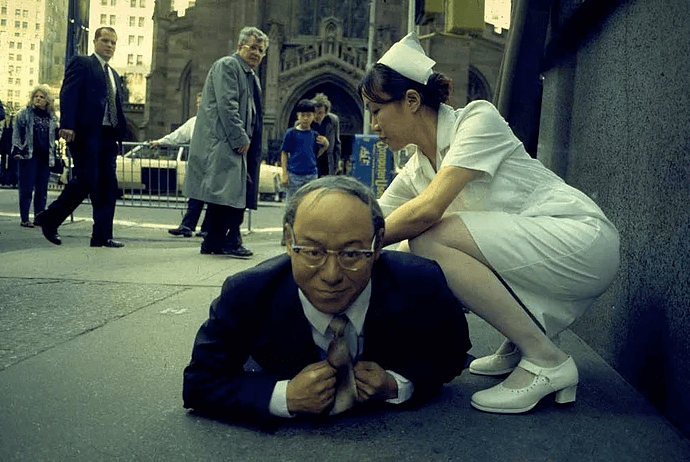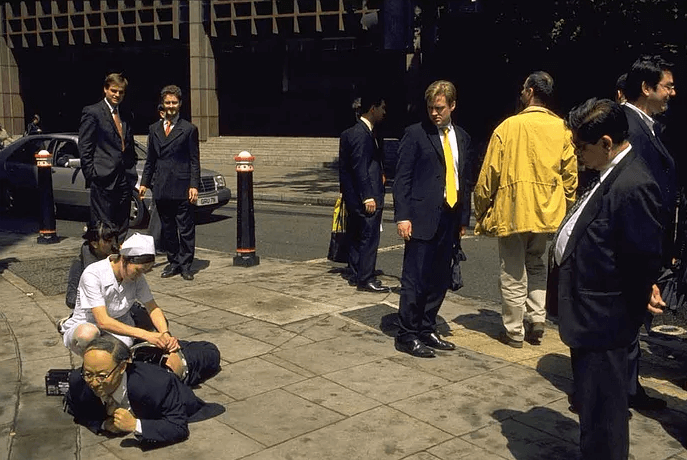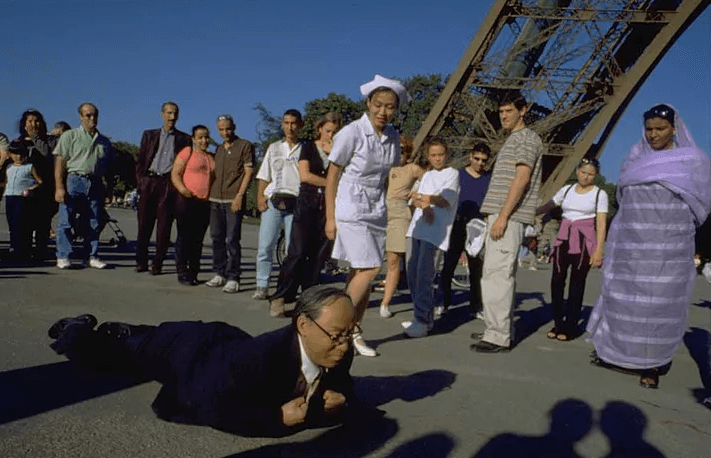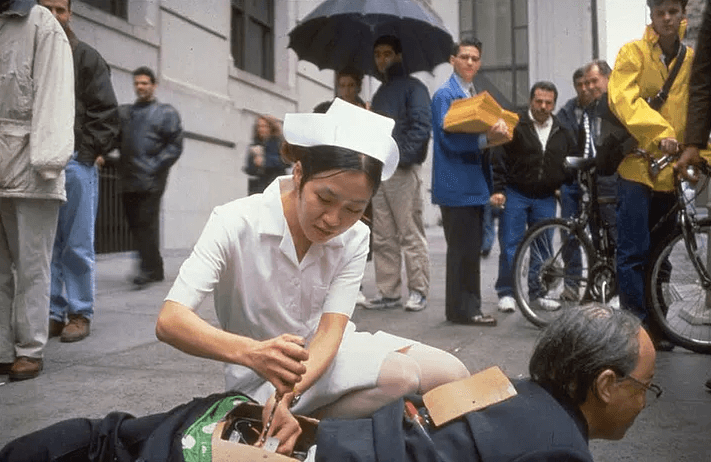The Japanese ‘Salaryman’, Crawling Across the World
The performance involving a robot experiencing burnout in the streets and Momoyo Torimitsu's critique of the system struck the art world.

“Performance on Wall Street”, NY 1997, Momoyo Torimitsu
Miyata Jiro was Momoyo Torimitsu‘s first project. Between 1994 and 2001, her anthropomorphic and ultra-realistic robot—just like the salarymen who overran the streets of Tokyo at the time—crawled through the world’s megalopolises. Dressed as a nurse, the artist follows the robot and helps him as he struggles, in the throes of death, in front of a stunned audience. Through this absurd performance, the artist denounces a society made up of soldiers devoted to their work, in which the number of karoshi—heart attacks or suicides due to overworking—has shot up.
A graduate of Tama Art University, the artist, born in 1967, explains to Pen how, at the time, she was ‘struck by the work of Hans Haacke, Anselm Kiefer, and Magdalena Abakanowicz.’ Thus, she began to reflect on what elements of her cultural background had influenced her character. ‘I thought about the rapid economic growth that occurred in Japan when I was a child. Employees were known to be workaholics: they did karaoke and then went to hostess bars to let off steam, but also to continue business meetings.’ She also remembers the ‘grown-up comic books they read while commuting for hours by train to central Tokyo.’
Beyond misogyny and suicide lies hope
Miyata Jiro—an ‘unremarkable’ name chosen more or less at random—did not limit his wanderings to Tokyo. In the years that followed, the performance was staged on the streets of New York, London, Sydney, Paris, and Rio de Janeiro, triggering different reactions. While the audience in Tokyo remained rational, wondering ‘Why is he crawling, why is he a robot?’, people in New York thought it was a publicity stunt. In London ‘most businessmen wear dark blue suits like Miyata, and they stood and looked at us but said nothing. But a couple of students, one African and the other Turkish, spoke to me. A major newspaper described the performance as “creepy”!’, the artist continues. In Sydney, ‘someone expressed an opinion about robots taking over from humans. Lots of people asked me about the concept behind the performance. A very old man went crazy!’ In Paris it was subject to many discussions, while in Rio de Janeiro ‘a young man who spoke neither English nor Japanese insisted on helping me in my performance; his grandfather was Japanese (my videographer was responsible for translating). It was just after the scandal involving Fujimori, the former President of Peru, and people in the street started shouting “Fujimori!!”’
Although the artist now lives in New York, when asked to express her feelings about how the situation has evolved, she considers that over twenty years after the project was launched, ‘it’s sad to see that Japan is still a male-dominated society, as illustrated by the 2021 scandal linked to the misogynistic remarks made by the President of the Tokyo Olympics Organising Committee, Yoshiro Mori. I read a few articles on the suicide rate in Japan. Although it’s higher for middle-aged men, an incredible number of women were affected in 2020 due to the pandemic. It wasn’t recorded as karoshi, but I think that was the case in a number of instances.’
But hope remains. ‘I’ve noticed online that the younger generations are becoming aware of these issues’, Momoyo Torimitsu concludes.
The artist’s other projects can be viewed on her website.

'Performance in London', 1999, Momoyo Torimitsu

'Performance in Paris', 2000, Momoyo Torimitsu

'Performance in Rio de Janeiro', 2001, Momoyo Torimitsu

'Performance on Wall Street', NY 1997, Momoyo Torimitsu
TRENDING
-
A House from the Taisho Era Reveals Its Secrets
While visiting an abandoned building, Hamish Campbell discovered photographs the owner had taken of the place in the 1920s.

-
The Taboo-Breaking Erotica of Toshio Saeki
The master of the 1970s Japanese avant-garde reimagined his most iconic artworks for a limited box set with silkscreen artist Fumie Taniyama.

-
With Meisa Fujishiro, Tokyo's Nudes Stand Tall
In the series 'Sketches of Tokyo', the photographer revisits the genre by bringing it face to face with the capital's architecture.

-
Masahisa Fukase's Family Portraits
In his series ‘Family’, the photographer compiles surprising photos in which he questions death, the inescapable.

-
Hajime Sorayama's Futuristic Eroticism
The illustrator is the pioneer for a form of hyperrealism that combines sensuality and technology and depicts sexualised robots.





